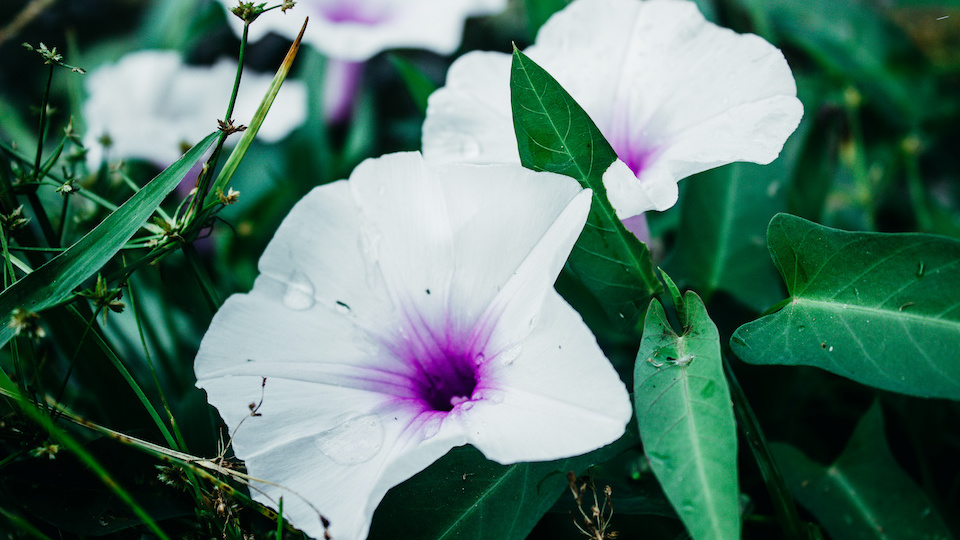Although you may be familiar with the host of pollinators that visit your garden during daylight hours such as hummingbirds, butterflies, and bumblebees you may not know about the secret night life in your garden. When these pollinators finish their shift and retire for the evening, the night shift comes on strong. Pollinators, including hawk moths, bats, and squash bees are known as crepuscular pollinators that work hard in the hours when other pollinators are resting. Creating a moonlight garden to draw these hard-working pollinators to your garden is easy and beautiful.
Best plants for a moonlight garden
This highly fragranced garden is full of voracious night bloomers that fill the evening air with their sweet perfume. Plant a night garden to maximize your time surrounded by exquisite flowers and draw the nighttime pollinators.
Here are four plants that will turn your backyard into a dusk to dawn pollinator paradise.
Moonflower
Sometimes called a tropical white morning glory or moon vine, this spectacular plant is native to tropical and subtropical regions. Enjoy gorgeous, scented blooms in the evening during the warmer months of the year.
- Planting: Sow seeds directly in garden ¼” deep when the soil reaches 50 degrees F or danger of frost has passed. 1 per sq. ft.
- Tips: Install a trellis and lightly twist the vine around it as it grows.
- Consider this: Soak seeds overnight before planting to encourage germination.
Night Phlox
Also known as midnight candy, night phlox opens up in the evening, setting free its delicious, honey-like fragrance. These compact plants look great in containers on a deck where they can be enjoyed. Enjoy this annual plant throughout the spring and summer growing season.
- Starting: Start seeds indoors ¼” deep, three to four weeks before the last expected frost date.
- Planting: Transplant into garden after danger of frost has passed. 1 per sq. ft.
- Tips: Pinch off spent blossoms to encourage more flowers.
Nicotiana
Known as flowering tobacco, nicotiana is a herbaceous perennial with tubular-shaped flowers. Varieties grow from 18 inches to 5 feet. Enjoy this annual plant while the weather stays warm.
- Starting: Start seeds indoors ⅛” deep, six weeks before the last expected frost date.
- Planting: Transplant into garden when all danger of frost has passed. 1 per sq. ft.
- Tips: Keep an eye out for aphids and gnats and use natural insect repellent as needed.
- Consider this: Plants will likely reseed for next season. Thin as needed when the new seedlings pop up or remove spent flowers right away to avoid reseeding.
4 O’Clocks
The name says it all! Flowers open around 4 o’clock in the afternoon and stay open till morning. Enjoy these brightly colored blooms in the cool of the evening.
- Starting: Start seeds indoors ¼” deep, six to eight weeks before the last expected frost. Perennial in zones 7b-11.
- Planting: Transplant into garden after all danger of frost has passed. 1 plant per sq. ft.
- Tips: Seeds can easily be collected to plant other places the following season.
- Consider this: The 4 O’Clock opens in the early
Enhance your moonlight garden with these easy-to-install elements
Add a place to sit
On warm summer evenings, you’ll want to have a comfy chair to sit and enjoy the sweet fragrance of your moon garden. If you don’t already have seating on your patio, consider a porch swing, wicker couch, or hammock.
Lighting
While this garden is best experienced in the soft light of the moon, you still want to be able to see your flowers on those, particularly cloudy, dark nights. Install soft lighting, such as strand of fairy lights, a few candles, or lanterns to set the mood.
Water feature
Moon gardens are all about serenity and unwinding from the craziness of life. What better way to relax than with the soothing sounds of a trickling water feature? Consider a small, enclosed waterfall, pond, or fountain. This will create a truly magical atmosphere and also provide a water source for bees, butterflies, hummingbirds, and other beneficial garden wildlife.
-Susan Patterson




